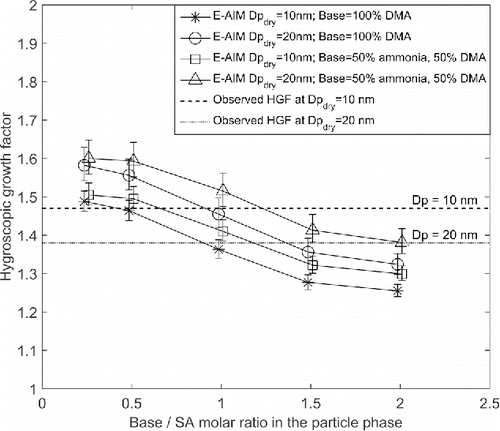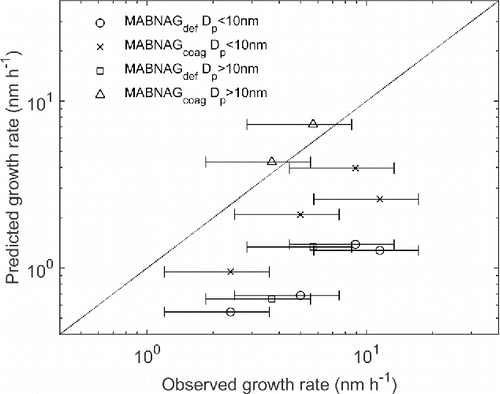Figures & data
Table 1. Observed HGFs for different DMA and SA gas phase concentrations in the CLOUD chamber (Kim et al. Citation2016), and particle phase base/acid ratios given as input to the simulations resulting in a predicted water uptake agreeing with the observed HGFs for 10, 15, and 20 nm dry diameter particles.
Figure 1. HGFs predicted by E-AIM for 10 and 20 nm dry diameter particles (stars, circles, squares, and triangles) and observed with nano-HTDMA (dashed and dotted lines) for the first experiment in with RH = 90 ± 2% in DMAwet. Each point (star, circle, square, or triangle) represents one simulation with the particle composition given on the x-axis. The error bars show the uncertainty in HGF due to uncertainty in RH in DMAwet.

Figure 2. Evolution of the particle chemical composition (a) based on: (Equation1[1] ) observations of positive and negative cluster composition using APi-TOF; (Equation2
[2] ) MABNAG simulations of the evolution of the chemical composition under the observed gas phase concentrations in the chamber; (Equation3
[3] ) E-AIM simulations of hygroscopic growth factors and comparisons to nano-HTDMA data; and direct observations by the TDCIMS. (b) The evolution of the aerosol pH as simulated by MABNAG. Solid and dashed lines in (a) and (b) represent simulations with assumed NH3 concentrations of 0 and 20 pptv, respectively. The temperature in the chamber was 278 K. The RH in the chamber was 38% and in the humidified DMA 90 ± 2%. The presented MABNAG simulations were run for chamber conditions of temperature and RH.
![Figure 2. Evolution of the particle chemical composition (a) based on: (Equation1[1] ) observations of positive and negative cluster composition using APi-TOF; (Equation2[2] ) MABNAG simulations of the evolution of the chemical composition under the observed gas phase concentrations in the chamber; (Equation3[3] ) E-AIM simulations of hygroscopic growth factors and comparisons to nano-HTDMA data; and direct observations by the TDCIMS. (b) The evolution of the aerosol pH as simulated by MABNAG. Solid and dashed lines in (a) and (b) represent simulations with assumed NH3 concentrations of 0 and 20 pptv, respectively. The temperature in the chamber was 278 K. The RH in the chamber was 38% and in the humidified DMA 90 ± 2%. The presented MABNAG simulations were run for chamber conditions of temperature and RH.](/cms/asset/83842724-b743-4ef0-803a-5e2b67404e4e/uast_a_1223268_f0002_c.gif)
Figure 3. MABNAG simulation with the DMA gas phase concentration being equal to 40 pptv. The plots show change during growth for (a) molar fractions in the particle phase of SA, DMA, and water; (b) surface tension and particle density; (c) mass fraction in the particle phase.

Table 2. Particle diameter interval, average gas phase concentration, and observed and predicted growth rates with MABNAG default version and with self-coagulation between particles included during six different experiments in ion-free conditions in the CLOUD chamber.
Figure 4. Simulated versus observed growth rates using the default version of MABNAG (circles and squares) and MABNAGcoag with monodisperse coagulation included (crosses and triangles). Circles and crosses denote growth rates with initial size below 10 nm, and squares and triangles denote growth rates with initial size above 10 nm. The horizontal bars indicate the uncertainty in the observations.

